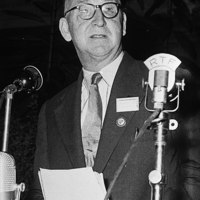Skip to main content
Sir J. Cockcroft
Item
-
Description
Sir John Douglas Cockcroft (27 May 1897 – 18 September 1967) was a British physicist who shared with Ernest Walton the Nobel Prize in Physics in 1951 for splitting the atomic nucleus, and was instrumental in the development of nuclear power. After service on the Western Front with the Royal Field Artillery during the Great War, Cockcroft studied electrical engineering at Manchester Municipal College of Technology whilst he was an apprentice at Metropolitan Vickers Trafford Park and was also a member of their research staff. He then won a scholarship to St. John's College, Cambridge, where he sat the tripos exam in June 1924, becoming a wrangler. Ernest Rutherford accepted Cockcroft as a research student at the Cavendish Laboratory, and Cockcroft completed his doctorate under Rutherford's supervision in 1928. With Ernest Walton and Mark Oliphant he built what became known as a Cockcroft–Walton generator. Cockcroft and Walton used this to perform the first artificial disintegration of an atomic nucleus, a feat popularly known as splitting the atom. During the Second World War Cockcroft became Assistant Director of Scientific Research in the Ministry of Supply, working on radar. He was also a member of the committee formed to handle issues arising from the Frisch–Peierls memorandum, which calculated that an atomic bomb could be technically feasible, and of the MAUD Committee which succeeded it. In 1940, as part of the Tizard Mission, he shared British technology with his counterparts in the United States. Later in the war, the fruits of the Tizard Mission came back to Britain in the form of the SCR-584 radar set and the proximity fuze, which were used to help defeat the V-1 flying bomb. In May 1944, he became director of the Montreal Laboratory, and oversaw the development of the ZEEP and NRX reactors, and the creation of the Chalk River Laboratories. After the war Cockcroft became the director of the Atomic Energy Research Establishment (AERE) at Harwell, where the low-powered, graphite-moderated GLEEP became the first nuclear reactor to operate in western Europe when it was started on 15 August 1947. This was followed by the British Experimental Pile 0 (BEPO) in 1948. Harwell was involved in the design of the reactors and the chemical separation plant at Windscale. Under his direction it took part in frontier fusion research, including the ZETA program. His insistence that the chimney stacks of the Windscale reactors be fitted with filters was mocked as Cockcroft's Folly until the core of one of the reactors ignited and released radionuclides during the Windscale fire of 1957. From 1959 to 1967, he was the first Master of Churchill College, Cambridge. He was also chancellor of the Australian National University in Canberra from 1961 to 1965. (Wikipedia)
Linked resources
Items with "Performer/Speaker : Sir J. Cockcroft"
| Title |
Class |
| Seekers, The |
CreativeWork
|
 Sir J. Cockcroft
Sir J. Cockcroft